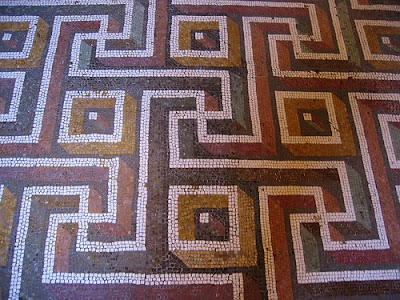 The Greek Key Pattern is becoming a key motif in interior design and rather than present contemporary examples, I thought I would look back to some very early examples and ways in which it has been appropriated in more recent times.
The Greek Key Pattern is becoming a key motif in interior design and rather than present contemporary examples, I thought I would look back to some very early examples and ways in which it has been appropriated in more recent times. Silk dress with velvet Greek key pattern trim, 1855. This was worn by a girl aged about four years. From The Museum of Childhood, Bethnal Green, London
Silk dress with velvet Greek key pattern trim, 1855. This was worn by a girl aged about four years. From The Museum of Childhood, Bethnal Green, London Mosaic floor illustration from classicaljournal.org
Mosaic floor illustration from classicaljournal.org
In the lobby of The Longacre Theater, Broadway recently restored at http://wirednewyork.com/forum

Parts of the Phillip ivory shield found in the Vergina Tomb, Central Macedonia, Greece at
ancient-medieval-macedonian-history.blogspot.com
 Directoire gown worn with red shawl with Greek key border, from Costume Parisien, 1799 at
Directoire gown worn with red shawl with Greek key border, from Costume Parisien, 1799 athttp://www.tetradequestrian.com
 Cast iron Greek Revival style balcony at http://www.hiddenhousehistory.co.uk
Cast iron Greek Revival style balcony at http://www.hiddenhousehistory.co.uk A detail from the former Detroit Savings Bank from pinehurst19475 at Flickr
A detail from the former Detroit Savings Bank from pinehurst19475 at Flickr
Mosaic floor from http://mosaicartsource.wordpress.com
Top: Archaeological Museum in Milan, (Italy). Fragment of an ancient Roman (1st century BC) mosaic. Picture by Giovanni Dall'Orto




































carpe k'iam. (d'iam)
ReplyDeleteyou have seized some great greek key patterns.
stunning.
pve
I really enjoyed this post on the "eternity symbol". My husband and I wear this symbol on our wedding bands!
ReplyDeleteI have some of the Costume Parisien- I am taken most with the ones that are half turned or with back to- like this one. You would know maybe- why so many like this? faces hard to do? G
ReplyDeleteIt's a puzzle isn't it. I personally think faces at any angle are more tricky than straight on. Maybe it's something to do with the cut of the clothes!!
ReplyDeleteit is my belief that the Greek key design is related to the labyrinth in some way. It may have preceded the labyrinth or was inspired by the labyrinth.
ReplyDeleteThank you for that Anonymous. I had never thought about the labryinth
ReplyDeletebut it's a fascinating theory. The presence of what is now seen as the swastika can come as a shock. I think the key pattern has many secrets!
Central Macedonia, Greece woooow !
ReplyDeleteMACEDONIA WAS NEVER GREEK YOU GYPSI-AFRICANS !
Oops, sorry to offend. What's with the gypsi-african bit? A historic reference, no doubt. I'm of the anglo-saxon variety myself.
ReplyDelete